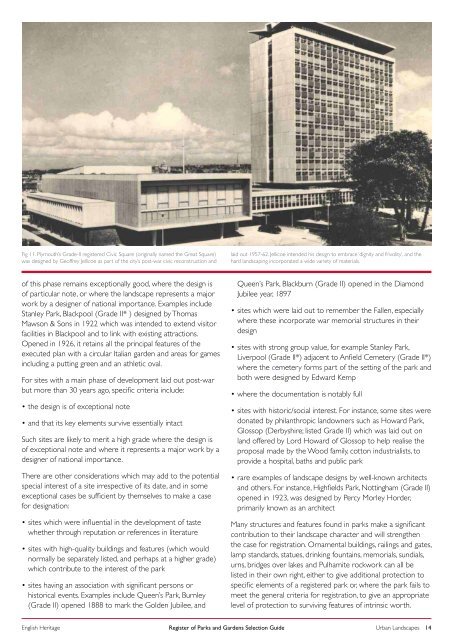Urban Landscapes - English Heritage
Urban Landscapes - English Heritage
Urban Landscapes - English Heritage
Create successful ePaper yourself
Turn your PDF publications into a flip-book with our unique Google optimized e-Paper software.
Fig 11. Plymouth’s Grade-II registered Civic Square (originally named the Great Square)<br />
was designed by Geoffrey Jellicoe as part of the city’s post-war civic reconstruction and<br />
laid out 1957-62. Jellicoe intended his design to embrace ‘dignity and frivolity’, and the<br />
hard landscaping incorporated a wide variety of materials.<br />
of this phase remains exceptionally good, where the design is<br />
of particular note, or where the landscape represents a major<br />
work by a designer of national importance. Examples include<br />
Stanley Park, Blackpool (Grade II* ) designed by Thomas<br />
Mawson & Sons in 1922 which was intended to extend visitor<br />
facilities in Blackpool and to link with existing attractions.<br />
Opened in 1926, it retains all the principal features of the<br />
executed plan with a circular Italian garden and areas for games<br />
including a putting green and an athletic oval.<br />
For sites with a main phase of development laid out post-war<br />
but more than 30 years ago, specific criteria include:<br />
• the design is of exceptional note<br />
• and that its key elements survive essentially intact<br />
Such sites are likely to merit a high grade where the design is<br />
of exceptional note and where it represents a major work by a<br />
designer of national importance.<br />
There are other considerations which may add to the potential<br />
special interest of a site irrespective of its date, and in some<br />
exceptional cases be sufficient by themselves to make a case<br />
for designation:<br />
• sites which were influential in the development of taste<br />
whether through reputation or references in literature<br />
• sites with high-quality buildings and features (which would<br />
normally be separately listed, and perhaps at a higher grade)<br />
which contribute to the interest of the park<br />
• sites having an association with significant persons or<br />
historical events. Examples include Queen’s Park, Burnley<br />
(Grade II) opened 1888 to mark the Golden Jubilee, and<br />
Queen’s Park, Blackburn (Grade II) opened in the Diamond<br />
Jubilee year, 1897<br />
• sites which were laid out to remember the Fallen, especially<br />
where these incorporate war memorial structures in their<br />
design<br />
• sites with strong group value, for example Stanley Park,<br />
Liverpool (Grade II*) adjacent to Anfield Cemetery (Grade II*)<br />
where the cemetery forms part of the setting of the park and<br />
both were designed by Edward Kemp<br />
• where the documentation is notably full<br />
• sites with historic/social interest. For instance, some sites were<br />
donated by philanthropic landowners such as Howard Park,<br />
Glossop (Derbyshire; listed Grade II) which was laid out on<br />
land offered by Lord Howard of Glossop to help realise the<br />
proposal made by the Wood family, cotton industrialists, to<br />
provide a hospital, baths and public park<br />
• rare examples of landscape designs by well-known architects<br />
and others. For instance, Highfields Park, Nottingham (Grade II)<br />
opened in 1923, was designed by Percy Morley Horder,<br />
primarily known as an architect<br />
Many structures and features found in parks make a significant<br />
contribution to their landscape character and will strengthen<br />
the case for registration. Ornamental buildings, railings and gates,<br />
lamp standards, statues, drinking fountains, memorials, sundials,<br />
urns, bridges over lakes and Pulhamite rockwork can all be<br />
listed in their own right, either to give additional protection to<br />
specific elements of a registered park or, where the park fails to<br />
meet the general criteria for registration, to give an appropriate<br />
level of protection to surviving features of intrinsic worth.<br />
<strong>English</strong> <strong>Heritage</strong> Register of Parks and Gardens Selection Guide<br />
<strong>Urban</strong> <strong>Landscapes</strong> 14

















